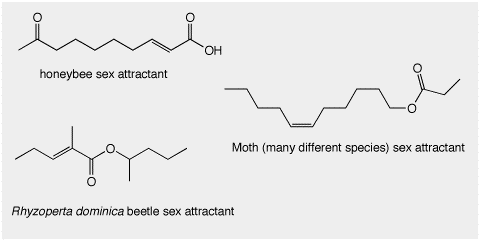
O-Chem in Real Life: Pheromones
Pheromones are simple organic chemicals that are used for communication. Their importance was recognized first in insects, although it seems pretty clear that mammals also use them (see below).
Pheromones have to be volatile, so that they can be easily distributed in the air, i.e. the molecules can't be too large. Pheromones are highly selective, however, so they can not be too small either, or the variety of molecular structures required for selectivity would not be possible. They also need to be fairly easily biosynthesized, i.e. in the bodies of the species that use them. Most of them contain around 10 - 17 carbons, and many contain C=O bonds. Some examples are shown below.

Here is a cool experiment. We have all seen ant trails that guide ants to food. In the case of Leptogenys diminuto, the ants "lay" these trails by secretion of (4S)-methyl-(3R)-heptanol. Note that the configuration of the two stereocenters is specified. As illustrated below, only this stereoisomer is active, the enantiomer and other diastereomers are completely ignored by the ants.

| OK, so exactly how many different compounds have the name 4-methyl-3-heptanol? |
So what about mammals? Mammals don't need pheromones as much as insects simply because their other communication methods (sound, vision, gestures etc.) are much more developed. Nevertheless, chemicals are certainly used by mammals. Amazingly, the asian elephant sex pheromone is identical to that of the moth whose structure is given above. As another example, antelopes release a chemical when alarmed that warns other animals in the vicinity.
And what about humans? I really don't know, as far as I can tell this is still under investigation. It certainly must be true, however, that if there is any use of pheromones by humans at all, it is very limited. It is speculated that the development of color vision in humans obviated the need for pheromones. If you do a web search on pheromones, however, you will find lots of people willing to sell you a human attractant pheromone!